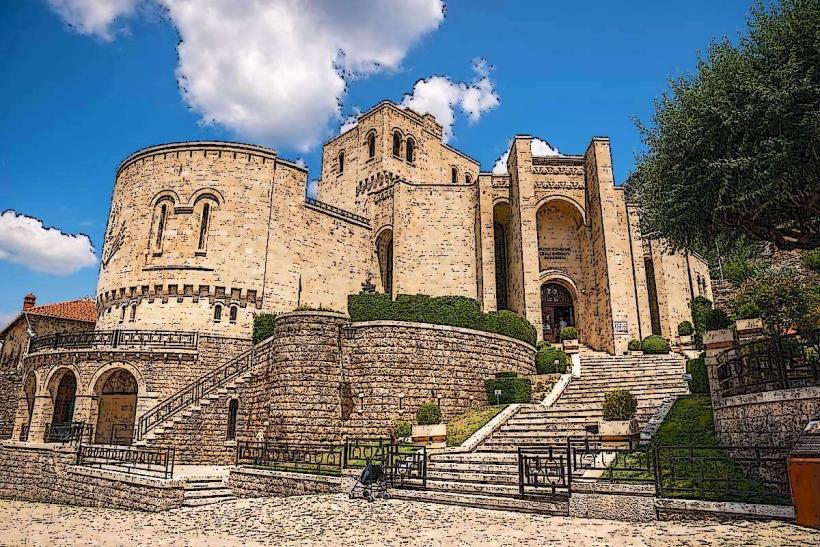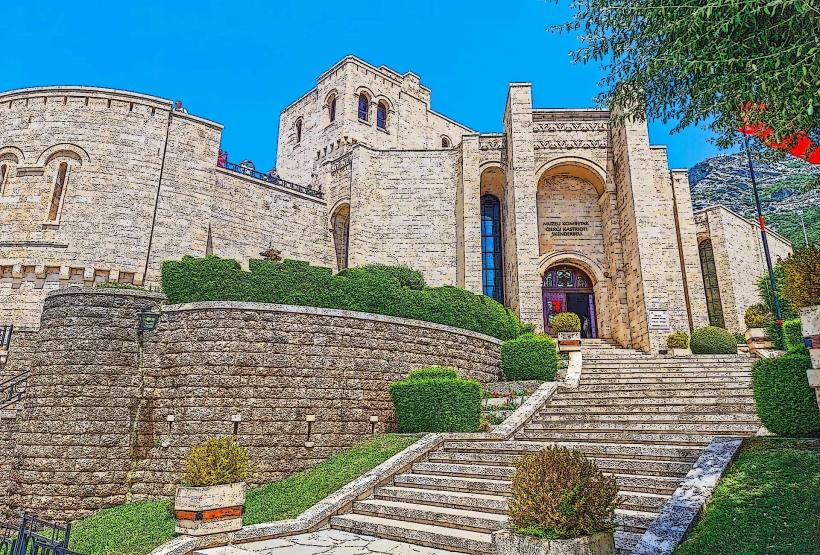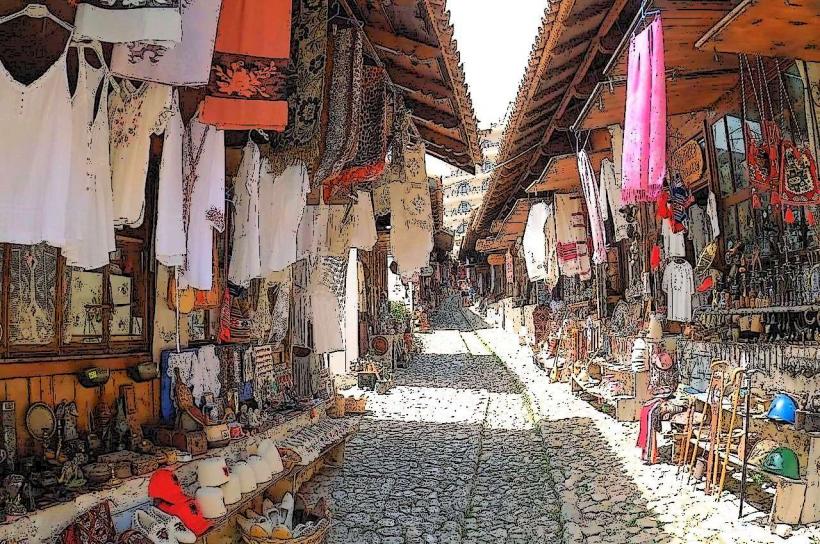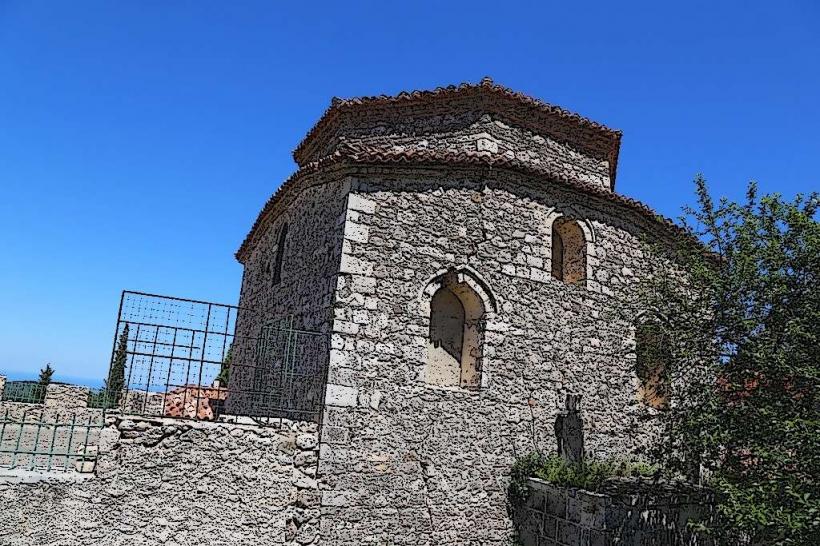Information
Landmark: Ethnographic MuseumCity: Kruje
Country: Albania
Continent: Europe
The Ethnographic Museum of Krujë (Muzeu Etnografik i Krujës) is one of the most important cultural institutions in Krujë, Albania. Located within the historical center of the town, the museum is dedicated to showcasing the traditional life, customs, and crafts of the region. It is housed in an Ottoman-era house, which itself is a historical artifact, providing visitors with an immersive experience of the lifestyle and culture of the area during the 18th and 19th centuries.
History and Significance
Cultural Heritage of Krujë:
- The Ethnographic Museum focuses on preserving and presenting the rich cultural heritage of Krujë and its surrounding areas. Krujë has a long history as an important urban center, dating back to the Ottoman period, and the museum provides a glimpse into the everyday life of the local population during this era.
- The museum highlights the traditional Albanian lifestyle, including architecture, furniture, textiles, and tools, while emphasizing local customs, crafts, and social practices that have been passed down through generations.
The Building's Historical Importance:
- The museum is housed in a traditional Albanian house that dates back to the Ottoman period, specifically the 18th century. The house is a great example of Ottoman domestic architecture in Albania, with its stone foundations, wooden beams, and a distinctive roof design. The house’s preservation allows visitors to step into a piece of Albanian history and understand how the people of Krujë lived in centuries past.
- The building itself is a piece of cultural heritage, and its inclusion in the museum adds historical value to the exhibits. The house is a rare example of traditional Albanian architecture and provides a direct connection to the past.
Museum Exhibits
Traditional Crafts and Artifacts:
- The Ethnographic Museum showcases a wide range of traditional crafts, including weaving, woodworking, and metalworking. Visitors can see how everyday items were made by hand, using techniques passed down through generations.
- The exhibits include woven rugs, embroidery, and traditional clothing worn by the local people. The intricate textiles are a testament to the region's rich craft traditions.
- Additionally, there are various tools used for daily tasks, from farming equipment to household items like pots, baskets, and utensils.
Albanian Rural Life:
- The museum gives visitors an in-depth look at rural life in Krujë and how it evolved over time. There are displays illustrating the different stages of daily life, from the home environment to agricultural work.
- You can view rooms that are furnished in the traditional style, complete with handmade furniture, ceramics, lamps, and other items that reflect the Albanian lifestyle in the past. The exhibits also feature vintage photographs that show how the people of Krujë and Albania lived in the 19th and early 20th centuries.
Traditional Clothing and Costumes:
- The museum has an extensive collection of traditional clothing from the region, which highlights the importance of clothing in Albanian cultural identity. Visitors can see elaborately embroidered costumes, headwear, and footwear, many of which are still worn in some rural areas of Albania.
- Costumes vary by region, with different styles for men and women, reflecting the cultural diversity of Albania. The displays emphasize the significance of traditional garments in social and cultural life.
Farming and Domestic Tools:
- The museum also displays a variety of farming tools, reflecting the importance of agriculture in the lives of the people in Krujë. Tools used for plowing, harvesting, and processing food are on display, providing insight into the agricultural practices that sustained the region for centuries.
- Domestic tools like wooden spoons, kettles, furniture, and clay pots give visitors a sense of how life was organized in the home, highlighting the self-sufficiency of families.
Social and Family Life:
- One of the main themes in the museum is the social structure of the community, focusing on the roles of men, women, and children in Albanian society during the Ottoman period. The exhibits showcase how families lived together, worked, and socialized.
- There are displays that explain the family traditions, marriage customs, and festivals that played a significant role in the community’s life.
Herbal Medicine and Folk Healing:
- A section of the museum is dedicated to folk medicine, showcasing the traditional healing practices of the region. Various herbs, medicinal plants, and remedies that were used by local healers are displayed, offering a glimpse into the ancient health practices that have been passed down through generations.
- Traditional healing instruments and recipes for remedies are also part of the museum's collection, which highlights the blend of nature and culture in Albanian medical practices.
Museum Layout and Experience
Rooms and Interior Design:
- The museum is set up with several rooms, each designed to evoke a different aspect of traditional life in Krujë. The rooms are arranged as if they were real living spaces, with furniture, textiles, and utensils placed as they would have been in a typical house.
- Visitors walk through replicas of kitchens, living rooms, and storage spaces, allowing them to experience the environment in a very personal way. The house also has a central courtyard typical of traditional Albanian homes, offering visitors a chance to see how outdoor spaces were used for daily activities.
Outdoor Space and Courtyard:
- The museum’s outdoor space includes a traditional garden and a courtyard, which reflects the importance of outdoor living in rural Albania. The garden often includes medicinal plants, herbs, and fruit trees, which were part of the traditional Albanian way of life.
Visiting the Museum
Opening Hours:
- The Ethnographic Museum of Krujë is typically open every day, with hours from 9:00 AM to 6:00 PM. It is advisable to check the hours before visiting as they may vary during the off-peak season or due to special events.
Entrance Fee:
- There is an entrance fee to visit the Ethnographic Museum. The ticket price is generally modest, and it often includes access to other nearby attractions such as Krujë Castle and the Skanderbeg Museum.
Guided Tours:
- Visitors can take guided tours of the museum to get a deeper understanding of the exhibits and the context behind the displays. These tours are available in several languages, including English, and provide insights into the cultural and historical significance of the items on display.
Best Time to Visit
- The best time to visit is during the spring (April to June) and fall (September to October), when the weather is pleasant, and there are fewer tourists. The museum can get busy during the summer months (July and August), so it may be more enjoyable to visit during the shoulder seasons.
Conclusion
The Ethnographic Museum of Krujë offers an excellent opportunity to learn about the traditional life and culture of Krujë and Albania as a whole. Through its collection of artifacts, costumes, and historical items, the museum paints a vivid picture of how people in the region lived, worked, and celebrated their cultural heritage during the Ottoman period. Whether you are a history enthusiast, a cultural traveler, or simply interested in the rich traditions of Albania, the museum is a fascinating and enriching experience.





